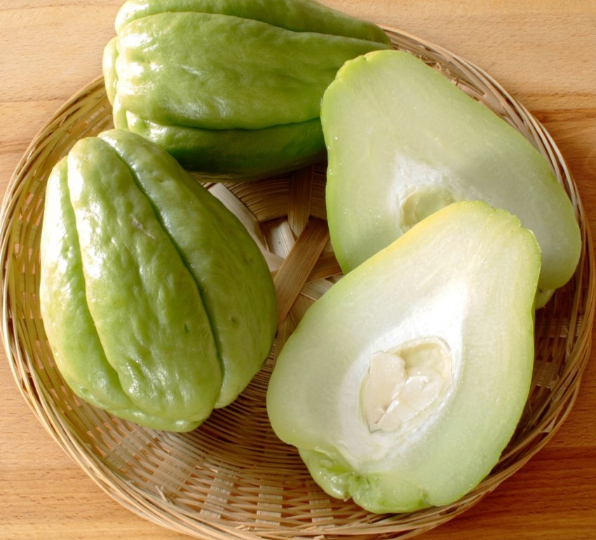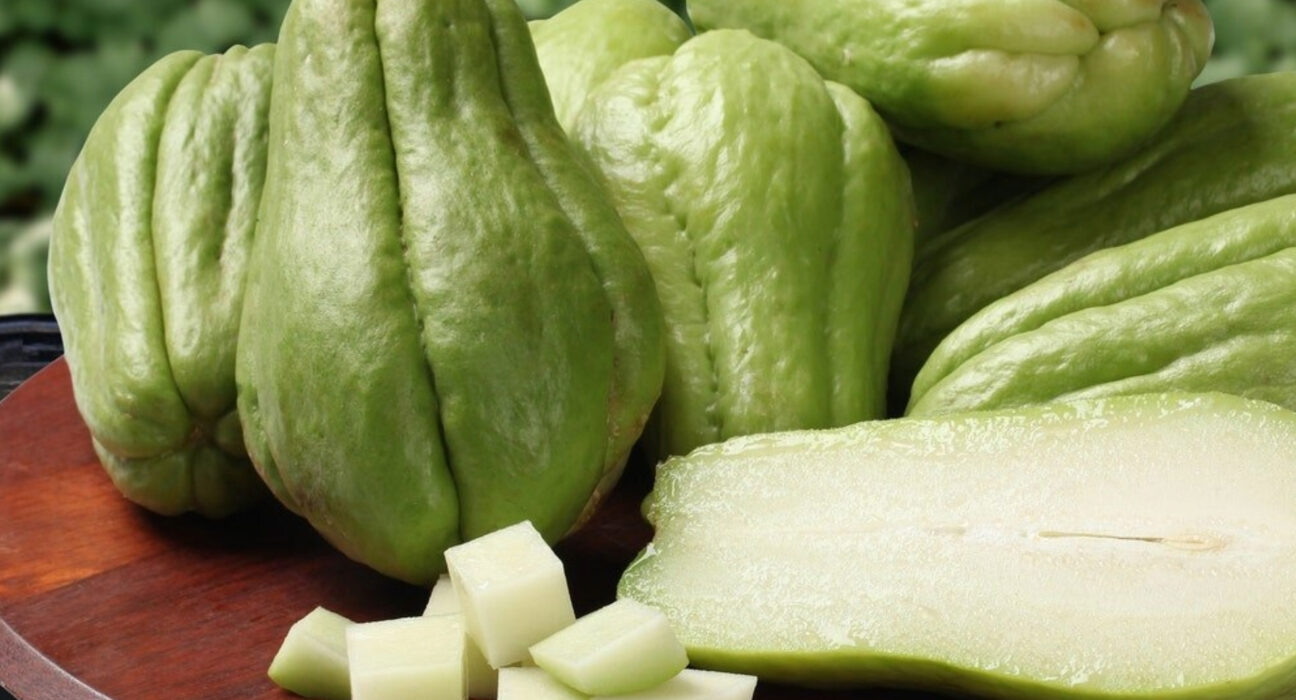Introduction:
Chayote, a unique and adaptable vegetable from the gourd family, is also referred to as vegetable pear, mirliton, or choko. Chayote, a native of Mexico and Central America, is well-known throughout the world for its delicious flavor, crisp texture, and exceptional nutritional value. This blog will discuss the advantages of chayote for health and how including this underappreciated vegetable in your diet can improve your general health and wellbeing.
1. Nutrient-Rich Composition
Chayote, often overlooked in the world of vegetables, boasts an impressive nutrient profile that belies its unassuming appearance. Rich in essential vitamins and minerals, including vitamins C, K, and various B-complex vitamins, as well as minerals such as potassium, magnesium, and manganese, chayote offers a myriad of health benefits that contribute to overall well-being.
Vitamin C, a potent antioxidant found abundantly in chayote, plays a crucial role in supporting immune function by enhancing the production and activity of white blood cells, which are responsible for defending the body against infections and illnesses. Additionally, vitamin C helps protect cells from oxidative damage caused by free radicals and promotes collagen synthesis, contributing to healthy skin, wound healing, and tissue repair.
Vitamin K, another important nutrient present in chayote, is essential for bone health and blood clotting. Adequate intake of vitamin K helps maintain bone density and reduces the risk of osteoporosis and fractures by promoting calcium deposition in bone tissue. Furthermore, vitamin K is involved in the synthesis of clotting factors in the blood, which are necessary for proper coagulation and wound healing.
The B-complex vitamins found in chayote, including folate, B6, and riboflavin, are integral to energy metabolism and cellular function. Folate, in particular, plays a critical role in DNA synthesis and cell division, making it essential for fetal development during pregnancy and for the production of red blood cells. Vitamin B6 is involved in neurotransmitter synthesis and supports brain function and mood regulation, while riboflavin contributes to energy production and the metabolism of carbohydrates, fats, and proteins.
Chayote also serves as a good source of essential minerals like potassium, magnesium, and manganese, which are involved in numerous physiological processes throughout the body. Potassium plays a key role in regulating blood pressure, muscle contraction, and nerve function, while magnesium supports bone health, muscle relaxation, and energy production. Manganese acts as a cofactor for various enzymes involved in antioxidant defense, metabolism, and bone formation.
2. High in Dietary Fiber
Chayote, often underestimated, is a powerhouse of dietary fiber, offering both soluble and insoluble fiber that plays a crucial role in maintaining optimal digestive health. This humble vegetable is an excellent addition to any diet, providing a range of benefits that contribute to overall well-being.
Dietary fiber is essential for digestive health as it adds bulk to the stool, regulates bowel movements, and promotes regularity. Chayote’s high fiber content helps prevent constipation by softening the stool and easing its passage through the digestive tract. Additionally, soluble fiber found in chayote forms a gel-like substance in the intestines, which helps slow down digestion and promote the absorption of nutrients.
Incorporating chayote into your diet can also support weight management and healthy eating habits. The fiber in chayote promotes feelings of fullness and satiety, reducing hunger cravings and the likelihood of overeating. By increasing the volume of food in the stomach without adding extra calories, chayote can help control appetite and curb excess calorie intake, thereby aiding in weight loss or weight maintenance efforts.
Furthermore, chayote’s high fiber content supports a healthy gut microbiome by serving as a prebiotic, a type of fiber that nourishes beneficial bacteria in the colon. These beneficial bacteria ferment fiber in the colon, producing short-chain fatty acids that provide energy for the cells lining the colon and contribute to overall gut health. A healthy gut microbiome is associated with a reduced risk of digestive disorders, inflammation, and chronic diseases.
Including chayote in your diet is easy and versatile. It can be enjoyed raw in salads, pickled, steamed, boiled, or sautéed as a nutritious side dish or incorporated into soups, stews, stir-fries, and casseroles for added flavor and texture. Whether eaten raw or cooked, chayote’s fiber-rich content makes it a valuable addition to a balanced and nutritious diet.
3.Low in Calories and Fat
Chayote emerges as a nutritional gem not only for its rich fiber content but also for its remarkably low calorie and fat profile, making it an ideal inclusion in various dietary plans, especially for individuals aiming to manage or shed excess weight. Its minimal calorie and fat content offer a guilt-free indulgence while providing a host of health benefits.
With its low-calorie nature, chayote serves as an excellent choice for those watching their caloric intake. Each serving of chayote contains a modest amount of calories, allowing individuals to enjoy a generous portion without worrying about excessive energy consumption. This characteristic makes it a versatile ingredient that can be incorporated into various meals and snacks without significantly contributing to overall calorie intake.
Furthermore, chayote’s low-fat content adds to its appeal for individuals seeking to maintain a healthy weight or reduce fat intake. While fat is an essential nutrient, excessive consumption can contribute to weight gain and various health issues. Chayote offers a nutritious alternative to higher-fat foods, allowing individuals to satisfy their hunger and cravings without compromising their dietary goals.
Incorporating chayote into meals can help boost volume and satiety without substantially increasing calorie or fat intake. Its mild flavor and versatile texture make it a versatile ingredient that can be used in salads, stir-fries, soups, stews, and side dishes. By adding chayote to meals, individuals can enhance the nutritional value of their dishes while enjoying a satisfying and filling eating experience.
Moreover, chayote’s low-calorie and low-fat profile aligns well with weight management strategies that focus on portion control and balanced nutrition. By including chayote in meals, individuals can create satisfying and nutritious dishes that support their weight management goals without feeling deprived or restricted.
4. Antioxidant Properties
Chayote, often underestimated in the realm of antioxidants, offers a rich array of these beneficial compounds, including vitamin C and flavonoids, that play a pivotal role in safeguarding cellular health and combating oxidative stress. By incorporating chayote into your diet on a regular basis, you can harness the antioxidant prowess of this humble vegetable to promote overall well-being and reduce the risk of chronic diseases.
Vitamin C, a potent antioxidant abundantly found in chayote, serves as a primary defense against free radicals, unstable molecules that can cause cellular damage and contribute to the development of various health issues. By neutralizing free radicals, vitamin C helps protect cells from oxidative stress, thereby reducing the risk of oxidative damage to DNA, proteins, and lipids. This protective effect extends to the cardiovascular system, where vitamin C helps maintain the integrity of blood vessels, supports healthy circulation, and reduces the risk of heart disease.
Flavonoids, another group of antioxidants present in chayote, exert anti-inflammatory and antioxidant effects that further bolster cellular defense mechanisms. These bioactive compounds help scavenge free radicals, inhibit inflammation, and modulate cellular signaling pathways involved in disease development. By reducing inflammation and oxidative stress, flavonoids contribute to the prevention of chronic diseases such as cancer, diabetes, and inflammation-related conditions like arthritis and autoimmune disorders.
Regular consumption of chayote as part of a balanced diet provides a steady supply of antioxidants that work synergistically to protect cells from damage and promote overall health. Whether enjoyed raw in salads, cooked in stir-fries, or incorporated into soups and stews, chayote offers a flavorful and nutritious way to enhance your antioxidant intake and support your body’s natural defense mechanisms.
5. Versatile Culinary Uses
Chayote’s versatility in the kitchen knows no bounds, owing to its mild flavor and crisp texture, making it an exceptional ingredient for a wide array of culinary creations. Whether raw or cooked, chayote lends itself beautifully to various dishes, offering a refreshing and nutritious addition to your meals.
Raw chayote makes a delightful addition to salads, imparting a crisp and refreshing crunch that complements leafy greens and other vegetables. Simply slice or julienne chayote and toss it with your favorite salad ingredients, such as tomatoes, cucumbers, bell peppers, and herbs, for a vibrant and nutritious salad bursting with flavor and texture.
When it comes to cooked dishes, chayote shines in stir-fries, soups, and stews, adding a subtle sweetness and satisfying crunch to each bite. Sliced or cubed chayote can be sautéed with garlic, onions, and other vegetables in a stir-fry, creating a colorful and flavorful dish that pairs well with rice or noodles. In soups and stews, chayote absorbs the flavors of the broth while retaining its texture, providing a delightful contrast to tender meats and hearty vegetables.
For a more creative culinary endeavor, try cooking chayote whole and stuffing it with savory fillings for a nutritious and satisfying meal. Cut the chayote in half lengthwise, scoop out the seeds, and fill the cavity with a mixture of seasoned ground meat, rice, vegetables, and herbs. Bake or steam the stuffed chayote until tender, and enjoy a wholesome and flavorful dish that’s sure to impress.
Chayote’s versatility extends beyond savory dishes—it can also be incorporated into sweet treats such as jams, chutneys, and desserts. Its mild flavor pairs well with fruits like apples, pears, and citrus, adding a subtle sweetness and refreshing crunch to jams and preserves. Chayote can also be used in baked goods such as pies, muffins, and cakes, lending moisture and texture to your favorite recipes.
6. Supports Hydration
Chayote, with its remarkable water content, serves as an outstanding ally in maintaining optimal hydration levels, especially crucial during periods of hot weather or post-exercise when fluid replenishment is vital. Embracing chayote as a dietary staple not only ensures adequate hydration but also contributes to various aspects of overall health and well-being.
The high water content of chayote, comprising approximately 90% of its weight, positions it as an excellent hydrating food choice. Incorporating chayote into your meals or snacks provides a hydrating boost, aiding in the replenishment of lost fluids and electrolytes. Whether enjoyed raw in salads or cooked in savory dishes, chayote offers a refreshing and thirst-quenching quality that can help combat dehydration and promote hydration from within.
Proper hydration is essential for maintaining healthy skin, as dehydration can lead to dryness, dullness, and premature aging. By consuming hydrating foods like chayote, you support skin health by ensuring adequate moisture levels, resulting in a hydrated, radiant complexion. Additionally, adequate hydration supports the skin’s natural functions, such as regulating temperature and removing toxins, further enhancing its overall appearance and vitality.
Incorporating chayote into your diet can also aid in regulating body temperature, particularly in hot climates or during strenuous physical activity. The water content of chayote helps regulate internal body temperature by facilitating sweat production and evaporative cooling, thereby preventing overheating and heat-related ailments. This makes chayote an excellent choice for staying cool and hydrated, especially during warmer months or outdoor activities.
Furthermore, chayote’s hydrating properties extend beyond simple fluid replenishment, as they also contribute to overall hydration status and fluid balance within the body. Proper hydration is essential for supporting various bodily functions, including digestion, nutrient absorption, circulation, and waste elimination. By consuming hydrating foods like chayote regularly, you help maintain fluid balance, optimize bodily functions, and promote overall health and well-being.


Conclusion:
Chayote may be an unsung hero in the world of vegetables, but its nutritional benefits and culinary versatility make it a valuable addition to any healthy diet. Whether eaten raw or cooked, chayote offers a wealth of vitamins, minerals, fiber, and antioxidants that can support overall health and well-being. Incorporate this underrated vegetable into your meals and discover the countless ways it can boost your health and elevate your culinary creations.












